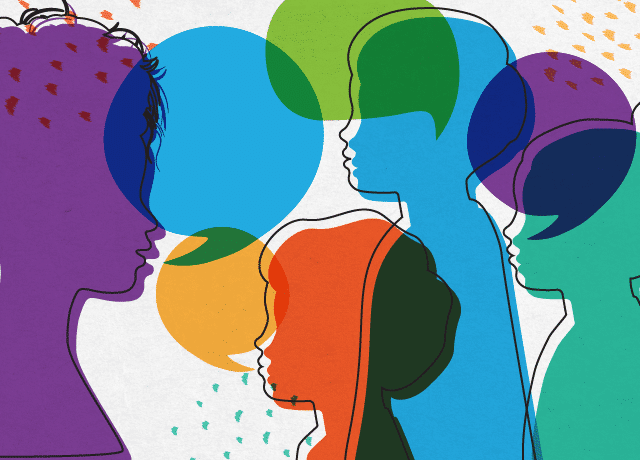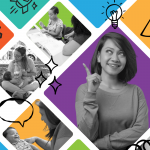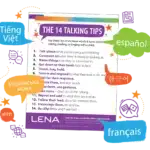[webinar]
Note: The data in this post, originally published April 18, 2023, has been updated.
Among the most important components of a high-quality early childhood education classroom is the quantity of responsive interactions between a teacher and the children in their care. These interactions, called conversational turns, play a critical role in building young children’s brains, boosting their social development and emotional health, and giving them the preliteracy skills they need to learn how to read. Unfortunately, children who are dual language learners (DLLs) may be missing out on these positive outcomes associated with conversational turns.
That’s according to new analysis of data from LENA’s “talk pedometer” technology, which suggests that toddler and preschool classrooms across the U.S. provide significantly fewer conversational turns for children who are DLL than for their monolingual, English-speaking peers.
“In classrooms where teachers don’t speak a child’s heritage language, we are seeing discrepancies in language interactions between children who speak heritage languages and children who only speak English,” said Dr. Jill Gilkerson, Chief Research and Evaluation Officer at LENA. “When it comes to addressing inequitable learning opportunities, promoting language development for children who use heritage languages is among the most important things we can do.”
[callout]
A mismatch between science and practice around children who are dual language learners
The science around early childhood development and multilingualism couldn’t be clearer:
- Children are perfectly wired to learn multiple languages simultaneously from birth.
- Multilingualism is an asset, not a deficit. The concept of language as a “barrier” is, simply put, wrongheaded and harmful.
- Children learning multiple languages show benefits in their cognitive abilities, executive function skills, and social-emotional development.
- Children’s English language development benefits even when their caregivers talk with them in a language other than English.
- One child’s bilingualism is not an impediment to another child’s learning — in fact, it’s quite the opposite. Children from monolingual families benefit as well when they interact with multilingual peers.
The science may be clear, but is it guiding real-world practice?
Dr. Dina Castro, director of the Boston University Institute for Early Childhood Well-Being and an authority on children who are DLLs, has a clear-cut answer: No. In a webinar hosted by The Hunt Institute, she said, “It seems like the practices and policies in early childhood care and education are not necessarily supporting or following the science in the way that it should.”
Or as the U.S. Department of Health and Human Services and the U.S. Department of Education put it in a joint policy statement about children who are DLLs: “[T]here is a mismatch between the learning experiences these children need to meet their potential, and the quality of experiences they are currently receiving.” [quote]
New data analysis from LENA’s researchers paints a clearer picture of just how those current practices and policies are failing dual language learners. Most studies examining language development in school have been conducted in elementary settings (at which point students who are learning multiple languages are usually referred to as English learners). Combine that with the fact that most research on language development in preschool classrooms has focused on monolingual English speakers, and a hole in the research becomes apparent.
We need to know more about how DLLs experience early childhood education classrooms, especially as they compose a greater and greater part of the U.S. population. Approximately one in three children aged 0-5 live in homes where at least one caregiver uses a heritage language(s), often alongside English. In some states, such as California, as many as one in two children who attend publicly funded early education programs, such as Head Start, are DLLs.
The data: Dual language learners in early childhood classrooms
LENA’s researchers focused on daylong audio recordings from 513 children in 64 classrooms across 17 U.S. states, including high representation from California, New Mexico, Arkansas, Florida, and New Jersey. Of the 64 classrooms, 19 had bilingual teachers (Spanish/English) and 45 had only monolingual teachers (English).
On average, DLLs experienced less interaction with monolingual teachers
In classrooms with only monolingual, English-speaking teachers, children who are DLLs experienced significantly fewer conversational turns (-7.5 turns per hour) than their monolingual peers in the same classroom. By contrast, in classrooms with bilingual teachers, there was only a marginal difference between DLLs and monolingual children. Our analysis does not allow us to know exactly what is causing these inequities, but other research suggests as solutions the expansion of access to professional development focused on DLL support and greater investment in the recruitment of multilingual educators.
An especially large gap in toddler classrooms
The gap was widest in toddler classrooms that did not have bilingual teachers. There, children who are DLLs experienced 14.7 fewer conversational turns per hour on average than their monolingual peers. By comparison, in toddler classrooms with bilingual teachers, DLLs experienced very similar amounts of interactive talk compared to children who are monolingual in the same classroom. According to prior LENA research published in the journal Pediatrics, this age range includes the critical period between 18 and 24 months, when conversational turn rates were most predictive of academic outcomes 10 years later.
On average, more DLLs experienced language isolation
Previous data analysis has shown that approximately one in five children in child care and preschool settings may experience language isolation. LENA’s researchers describe a child as experiencing language isolation if they engage in fewer than five conversational turns per hour for all but the single hour during which the most conversational turns occurred. For instance, arrival time or lunch time may result in more conversational turns, but otherwise the child experiences almost no back-and-forth interaction with a teacher throughout the day.
Now, there’s evidence to suggest that children who are DLLs are disproportionately likely to experience language isolation. In classrooms without bilingual teachers, children who are DLLs were four times more likely to be in language isolation than their monolingual peers.
Positive results from LENA Grow
LENA Grow is a professional development program for early childhood educators that uses “talk pedometer” technology to help teachers learn how to increase interaction levels equitably in their classrooms. There’s strong evidence to suggest that a classroom’s participation in LENA Grow has a beneficial impact on reducing language isolation, especially for children who are DLLs.
After LENA Grow, there was a significant reduction in the percentage of children experiencing language isolation. Only four percent of DLLs were experiencing language isolation at the end of the program, compared to 21 percent at the start.
In addition to its beneficial impact on language isolation, LENA Grow also had an impact on overall conversational turn rates. Children who are monolingual experienced an average increase in conversational turns per hour of 16 percent, and children who are DLLs experienced an even higher increase of 22 percent.
“What we observe for these rooms is rather remarkable, because the gains in interaction for one group does not mean the other children are experiencing less interaction,” Gilkerson said. “Teachers were able to increase conversational turns for all children.”
Where do we go from here?: Creating more inclusive classrooms
On a national scale, long-term academic outcomes for DLLs lag behind those of their monolingual peers, pointing to a need for greater support and training for teachers, greater linguistic diversity in the workforce, continued rebuttals of misguided myths, and more inclusive, linguistically responsive curriculums and assessments. And, as LENA’s analysis of language environments in early childhood education classrooms suggests, these long-term outcomes also point to a need for greater emphasis on equitable experiences for linguistically minoritized children in early childhood education settings.
It’s important to remember that each child’s individual experience of the classroom is unique.
DLLs are far from a homogeneous group, and one DLL’s experiences with English and with their heritage language(s) are sure to be different from another’s. While the current data analysis reveals a troubling trend in aggregate, it’s vital that any proposed solutions account for children’s individual experiences.
Part of what makes LENA’s technology unique is its capacity to deliver insights into those unique experiences. The question is: How do we translate those insights into real-world benefits for children who are DLLs and the educators who support them?
- Research-informed policy recommendations must be considered and implemented. As one report has put it, “Educational [justice] for DLLs requires including these students in the design and implementation of all early education programs.” Research suggests that Head Start’s Program Performance Standards for DLLs have yielded great outcomes for DLLs.
- In advance of slow-moving policy improvements, professional development opportunities must be made available to early childhood educators in the here and now. For example, Boston University’s Nuestros Niños project will offer an academic certificate in Teaching Young Dual Language Learners.
- Research must continue to be conducted on the instructional practices that lead to the best early learning experiences and outcomes for DLLs. First 5 California’s Dual Language Learner Pilot Study is a model example.
In addition, returning to the implications of the current data analysis, specialized professional development programs like LENA Grow can help educators develop data-informed strategies for better connecting with each and every child in their care. LENA Grow puts the “talk pedometer” technology into the hands of teachers themselves. Combining child-specific data feedback with weekly coaching enables educators to develop strategies for increasing their responsive interactions with the children who need them most.
In a 2023 webinar hosted by LENA, Pilar Fort, early childhood advisor with Whole Child International and a member of LENA’s Community Advisory Board, had a powerful message for all educators: “You have it already in your heart. But get rid of your fear. And go for it. Try it. Take a risk.”
[webinar]



